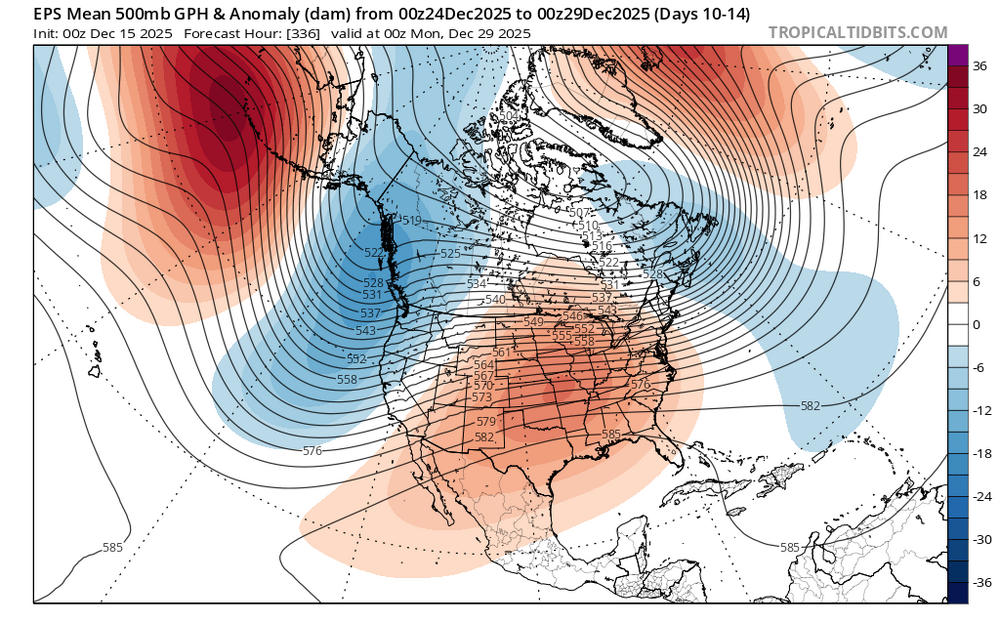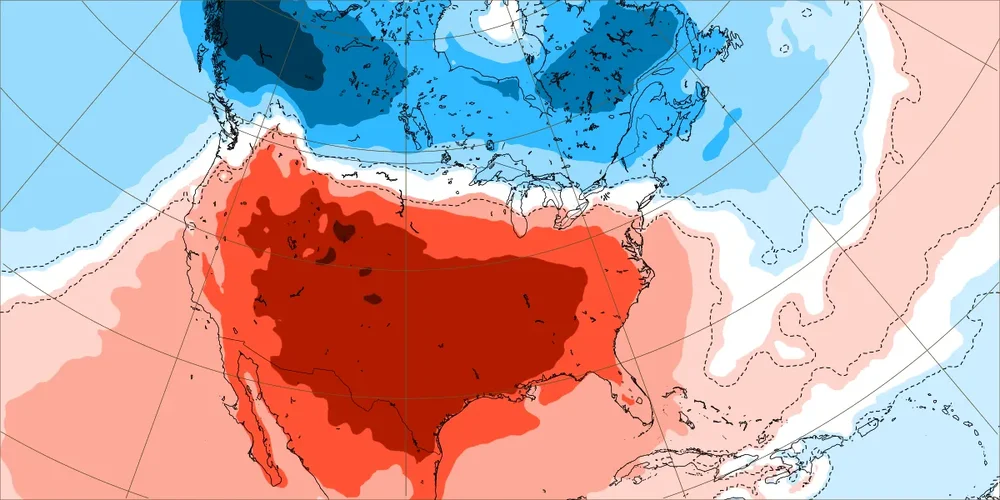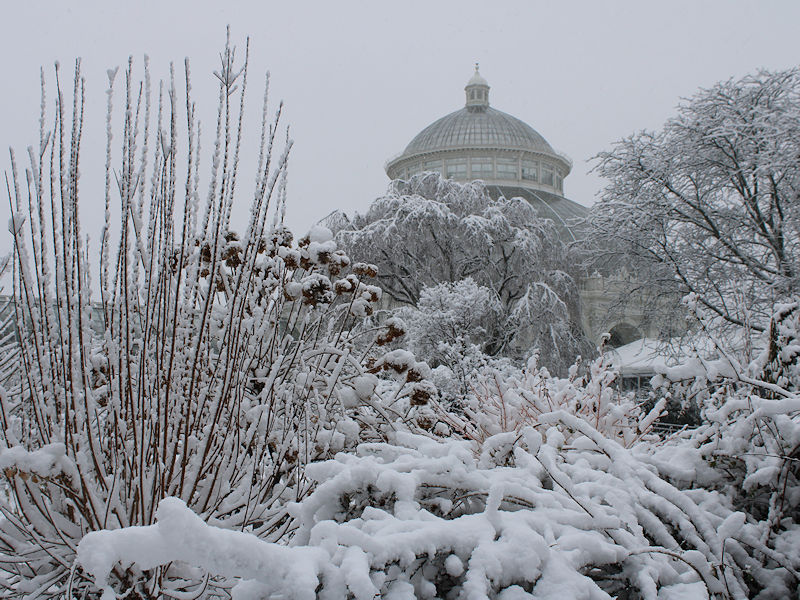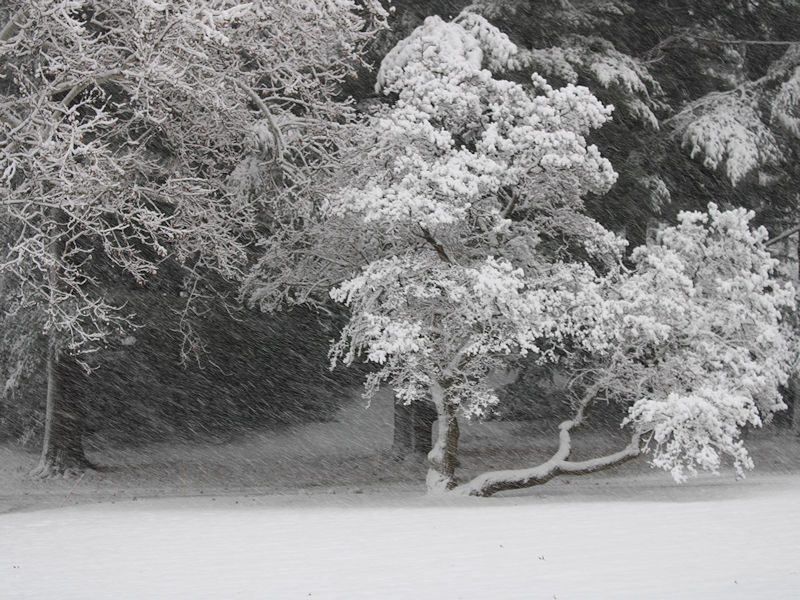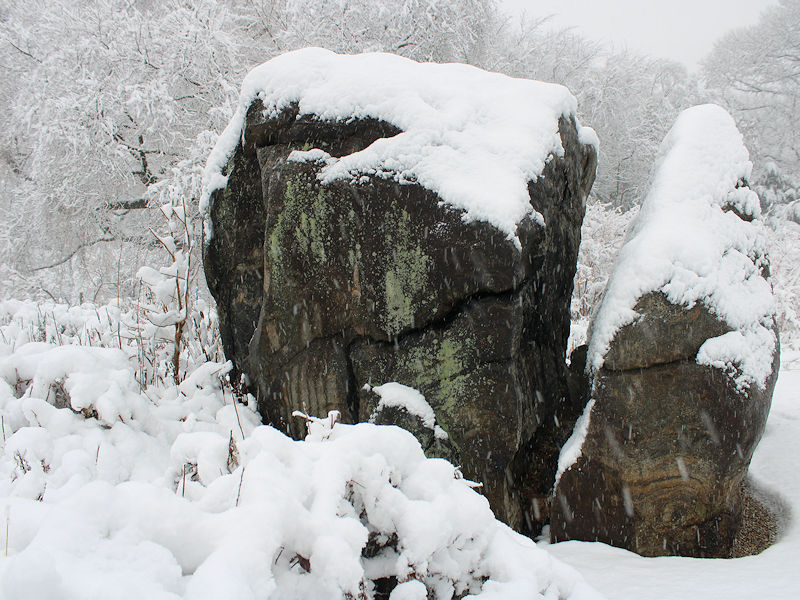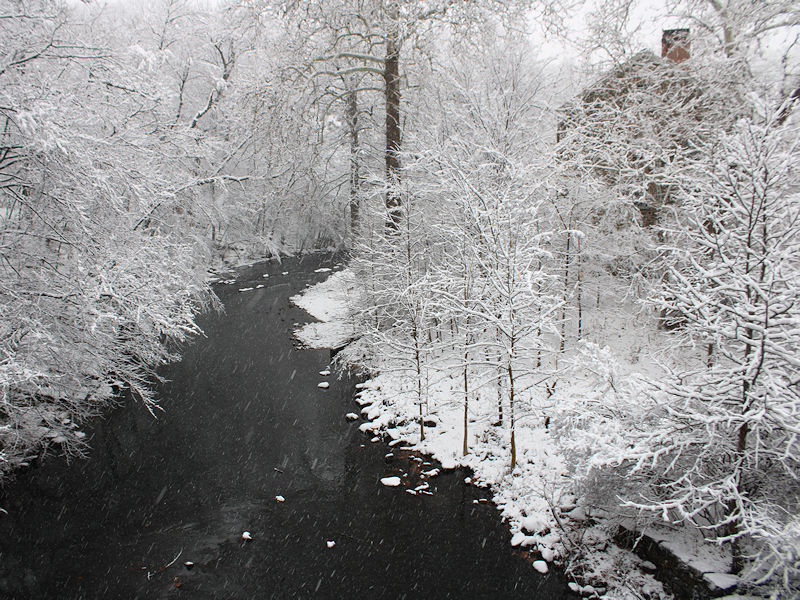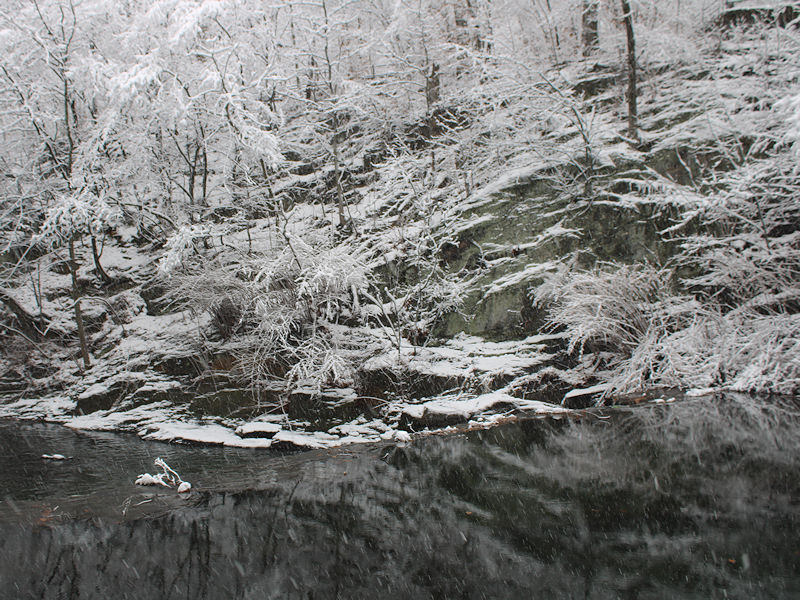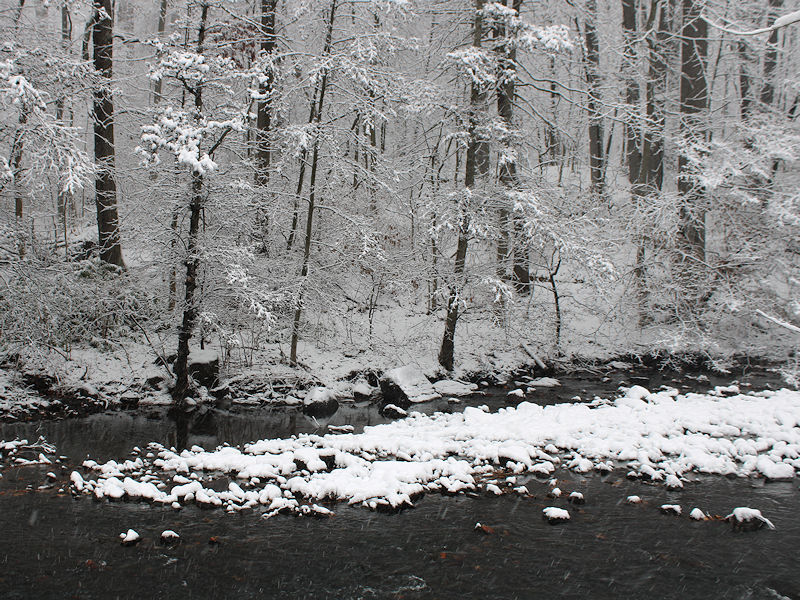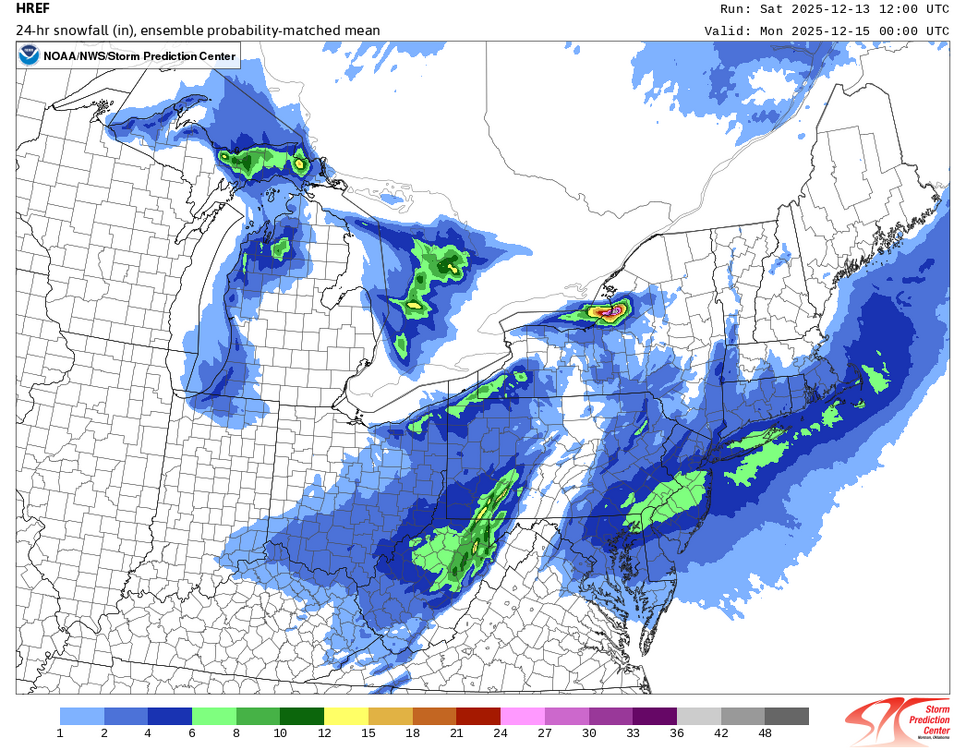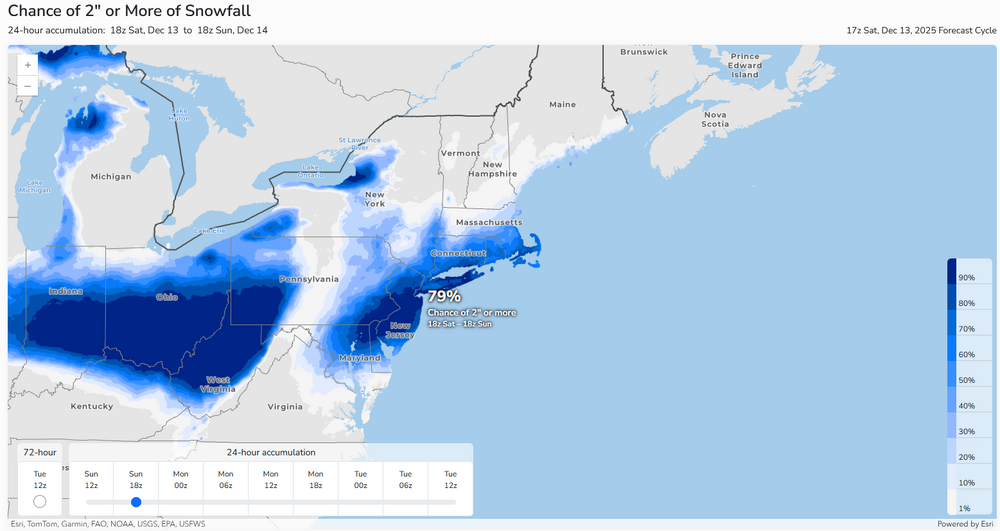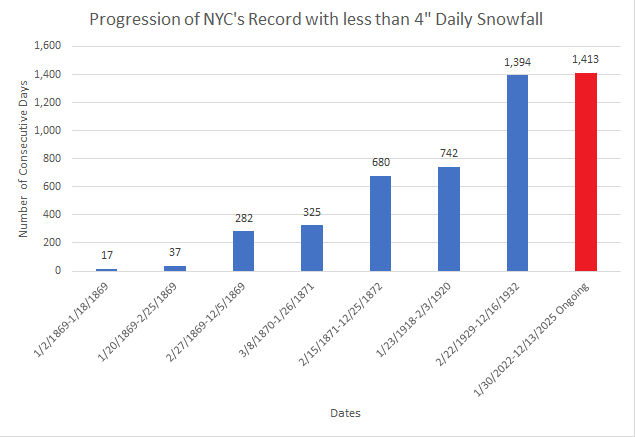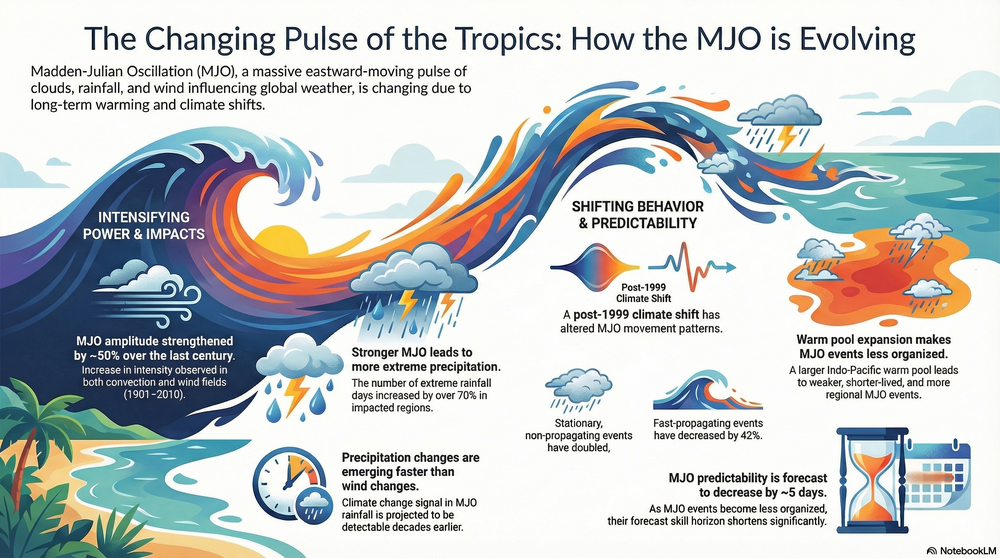-
Posts
23,166 -
Joined
Content Type
Profiles
Blogs
Forums
American Weather
Media Demo
Store
Gallery
Everything posted by donsutherland1
-

2025-2026 ENSO
donsutherland1 replied to 40/70 Benchmark's topic in Weather Forecasting and Discussion
New York City saw its coldest first two weeks of December since 2005. The cold was even more impressive elsewhere: Charlottesville, VA (3rd coldest); Jackson, KY (3rd coldest); Marquette (2nd coldest); Paducah (4th coldest); and, Scranton (5th coldest). There was also impressive warmth in other parts of the northwestern U.S. Boise (4th warmest); Burns, OR (2nd warmest); Missoula (3rd warmest); Pocatello (3rd warmest); and, Yakima (1st warmest). The most persistent teleconnections were the WPO- (which tanked) and the PNA-. Going forward, the WPO- is likely to become less negative, cutting off the unrelenting flow of cold air into western Canada and then the northern U.S. The EPO could go negative, which would blunt the full effects of warming across the northern tier of the U.S. and especially Canada. The PNA will remain persistently negative. The changes favor a Southeast ridge, strong trough in the Pacific Northwest, and a weakening trough over the Northeast and eastern Canada. Thus, the southern tier of the U.S. and perhaps most of the CONUS could see a warmer than normal December 20-31 period overall. The warmup could take time to develop in New England and the upper Midwest. Canada should remain broadly colder than normal for the period overall. The latest Day 10-14 forecast on the EPS illustrates a 500 mb pattern that is broadly what one would expect from the forecast teleconnections during that period. The GEFS is in good agreement with the EPS for that timeframe. Here's the December 22-29 weekly ECMWF forecast: Notice how New England and parts of the northernmost U.S. has near normal or even below normal temperatures. Canada is cold from coast-to-coast. Finally, the GEFS is showing a scenario similar to December 28-31, 2021 where warm anomalies develop in much of eastern Canada. Whether this is something that will occur toward the close of December or a bit later in January remains to be seen. The EPS and ECMWF weeklies keep eastern Canada cooler than normal albeit less cool than shown above through the remainder of December. For now, the EPS is the baseline scenario for the closing days of December. That would allow for some intrusions of cooler air into the Northeast. -
Yes. That's part of the random element of timing with such records. Those records are interesting but that's about it with them.
-
The 4.4" was an error. The NOWdata has now been corrected to 2.9". In the PNS, there was a report near Central Park that showed 3.1", so the 2.9" is probably reasonable (maybe several tenths low?) this time around.
-
Yes. Sometimes data gets in and is automatically flagged and corrected. Occasionally, errors persist and the corrections are made manually. The prior erroneous 72° high for October 2 is one such example. It was corrected in late November.
-
I'm waiting to hear back. The daily climate report and CF-6 showed 2.9". NOWdata, which goes into xmACIS, showed 4.4".
-
Walt, Thank you for all you have done throughout your career and here. Your generosity, skill, and class made an indelible difference wherever you've gone. I wish you continued health and time with your family. Very best wishes always, Don
-
Following the season's first appreciable snowfall, tomorrow will be blustery and cold. High temperatures will likely wind up below 30° in much of the region. Morning lows could challenge the coldest so far this season. The WPO has reached severely negative levels. That will likely contribute to the December 10-20 period being colder than normal overall. Moderation is possible late in the period as the WPO begins to rise. However, with the EPO forecast to go negative, exceptional warmth is unlikely. The probability that December 2025 will have a maximum monthly temperature below 60° is increasing. The last time that happened was in 2019 when the monthly high was 58°. If 2025 has a monthly high below 60°, that would be only the fifth such occurrence since 2000 (2003, 2004, 2005, and 2019 are the cases since 2000). The ENSO Region 1+2 anomaly was -0.2°C and the Region 3.4 anomaly was -0.5°C for the week centered around December 3. For the past six weeks, the ENSO Region 1+2 anomaly has averaged -0.27°C and the ENSO Region 3.4 anomaly has averaged -0.65°C. La Niña conditions will likely continue through at least mid-winter. The SOI was +9.50 today. The preliminary Arctic Oscillation (AO) was +1.900 today. Based on sensitivity analysis applied to the latest guidance, there is an implied near 95% probability that New York City will have a cooler than normal December (1991-2020 normal). December will likely finish with a mean temperature near 34.5° (4.6° below normal). Supplemental Information: The projected mean would be 2.9° below the 1981-2010 normal monthly value.
-

2025-2026 ENSO
donsutherland1 replied to 40/70 Benchmark's topic in Weather Forecasting and Discussion
If I raise it, I will do so near the end of December. -

2025-2026 ENSO
donsutherland1 replied to 40/70 Benchmark's topic in Weather Forecasting and Discussion
My thinking for seasonal snowfall for Central Park was 15"-25". It will be interesting to see how things evolve. -
-
Not yet. Hopefully, soon.
-
2 NE Springfield, NJ: 4.5"
-
Snow will overspread the region tonight and continue into tomorrow. It should taper off to flurries during the middle or latter part of the morning in New York City and early afternoon on Long Island. The New York City area will see a general 3"-5" snowfall with some locally higher amounts. Final estimates: Allentown: 2"-4" Atlantic City: 3"-5" Baltimore: 3"-5" Bridgeport: 2"-4" Islip: 3"-6" New York City: 3"-5" Newark: 3"-5" Philadelphia: 3"-6" Poughkeepsie: 1"-3" Washington, DC: 2"-4" In the wake of the system, tomorrow and Monday will be blustery and cold days. High temperatures will likely wind up below freezing. The WPO has reached severely negative levels. That will likely contribute to the December 10-20 period being colder than normal overall. Moderation is possible late in the period as the WPO begins to rise. The probability that December 2025 will have a maximum monthly temperature below 60° is increasing. The last time that happened was in 2019 when the monthly high was 58°. If 2025 has a monthly high below 60°, that would be only the fifth such occurrence since 2000 (2003, 2004, 2005, and 2019 are the cases since 2000). The ENSO Region 1+2 anomaly was -0.2°C and the Region 3.4 anomaly was -0.5°C for the week centered around December 3. For the past six weeks, the ENSO Region 1+2 anomaly has averaged -0.27°C and the ENSO Region 3.4 anomaly has averaged -0.65°C. La Niña conditions will likely continue through at least mid-winter. The SOI was +4.62 today. The preliminary Arctic Oscillation (AO) was +1.254 today. Based on sensitivity analysis applied to the latest guidance, there is an implied near 91% probability that New York City will have a cooler than normal December (1991-2020 normal). December will likely finish with a mean temperature near 34.7° (4.4° below normal). Supplemental Information: The projected mean would be 2.7° below the 1981-2010 normal monthly value.
-
Boston's record stretch with < 4" and < 5" daily snowfall ended at 1,028 days on December 19, 2024. Boston currently has a 1,387-day streak with < 6" of daily snowfall, which is the second longest such streak. The record is 1,772 consecutive days.
-
The 12/13 12z HREF is quite aggressive with the snowfall: If the areas are knocked down a level e.g., 4"-6" down to 2"-4", one still has good confidence in the idea of a widespread 2"-4" snowfall with higher amounts on parts of Long Island, NJ, and Philadelphia (generally 3"-6"). The latest probabilistic assessment of 2" or more snowfall.
-
I will check out Boston when I get home.
-
I enjoy all the snow I receive. Even 1 cm is appealing. Nevertheless, when posting statistics, even the ugly data (streak in my post) will be mentioned periodically for purposes of completeness.
-
Overnight runs have added some QPF to the New York City region into central Westchester County and southern Fairfield County. Ratios will probably be 11:1 to 13:1 across a good part of the region. Taking all this into consideration, my thinking is that the New York City area, including its nearby northern suburbs will see a general 2"-4" snowfall. A portion of New Jersey and Long Island could see higher amounts, especially as some Atlantic moisture could become involved as the system departs e.g., Islip could wind up with a 3"-5" snowfall. Recent Snowfall Thresholds for New York City: Storm Total Snowfall: Last 1" or above snowfall: February 11-12, 2025: 1.6" Last 2" or above snowfall: February 8-9, 2025: 3.1" Last 4" or above snowfall: January 28-29, 2022: 8.5" Daily Snowfall: Last 1" or above snowfall: February 11, 2025: 1.2" Last 2" or above snowfall: February 8, 2025: 3.0" Last 4" or above snowfall: January 29, 2022: 7.3" Given the timing of the snow's onset, today will very likely extend the record streak without 4" or above snowfall to 1,414 consecutive days for New York City. Farther south, Philadelphia is in line for a 3"-6" snowfall. The last time Philadelphia saw a 4" or greater snowstorm was January 19, 2024 when 4.6" fell. Philadelphia's last 6" or above snowstorm occurred during January 28-29, 2022 when 7.5" blanketed the city.
-
It will be increasingly cloudy and cold tomorrow. Light to moderate snow will overspread the region tomorrow night. The New York City area will see a general 1"-3" snowfall with a few locally higher amounts. In the wake of the system, Sunday and Monday will be blustery and cold days. High temperatures will likely wind up below freezing. The WPO is falling toward severely negative levels. That will likely contribute to the December 10-20 period being colder than normal overall. Moderation is possible late in the period as the WPO begins to rise. The probability that December 2025 will have a maximum monthly temperature below 60° is increasing. The last time that happened was in 2019 when the monthly high was 58°. If 2025 has a monthly high below 60°, that would be only the fifth such occurrence since 2000 (2003, 2004, 2005, and 2019 are the cases since 2000). The ENSO Region 1+2 anomaly was -0.2°C and the Region 3.4 anomaly was -0.5°C for the week centered around December 3. For the past six weeks, the ENSO Region 1+2 anomaly has averaged -0.27°C and the ENSO Region 3.4 anomaly has averaged -0.65°C. La Niña conditions will likely continue through at least mid-winter. The SOI was -4.67 today. The preliminary Arctic Oscillation (AO) was +0.811 today. Based on sensitivity analysis applied to the latest guidance, there is an implied near 89% probability that New York City will have a cooler than normal December (1991-2020 normal). December will likely finish with a mean temperature near 34.8° (4.3° below normal). Supplemental Information: The projected mean would be 2.6° below the 1981-2010 normal monthly value.
-

2025-2026 ENSO
donsutherland1 replied to 40/70 Benchmark's topic in Weather Forecasting and Discussion
It should be abundantly clear now that the plausible scenario of a warmup within a few days of December 20 has become the baseline scenario. The weakening WPO- regime coupled with unfavorable teleconnections will allow for most of the CONUS to see temperatures move above normal. The ongoing warmth will continue in the West, as well. It is also increasingly clear that the PNA will wind up predominantly negative this month. Most of Canada should remain cold beyond December 20, however eastern Canada, including Ontario and Quebec could begin to warm up several days later. -

Winter cancelled/uncancelled banter 25/26
donsutherland1 replied to Rjay's topic in New York City Metro
Maybe the "boo-birds" will be throwing snow balls, not hot water, on Sunday. -

Occasional Thoughts on Climate Change
donsutherland1 replied to donsutherland1's topic in Climate Change
I put a number of papers on how climate change has affected the MJO (many thanks to @bluewave for providing links in a number of posts/threads) and used Notebook LM to generate an infographic. That infographic is based solely on the literature. It is below: -
Yes, that's true. Parts of the FL might wind up having a top 10 warmest December. And many records are being set out West.
-
New York City finished December 1-10 with a mean temperature of 34.1F (1.2C). That was the coldest first 10 days of December since 2007 and sixth coldest since 2000. A quick look at the guidance shows that a light snow event (probably 1"-3") across the New York City area is likely on Sunday. Given how snow events have been challenging to come by in recent years, to some it might seem like a big event. Even the previously bone-dry NBM shows 0.12" QPF.


